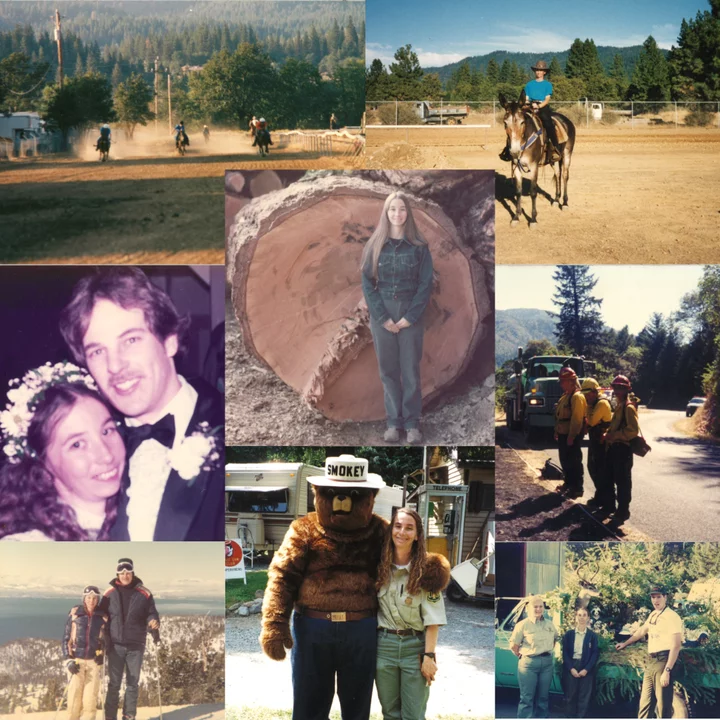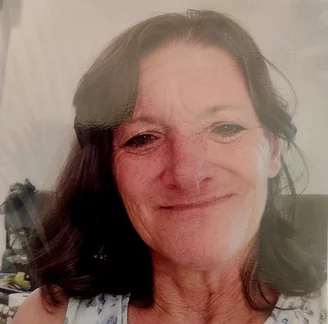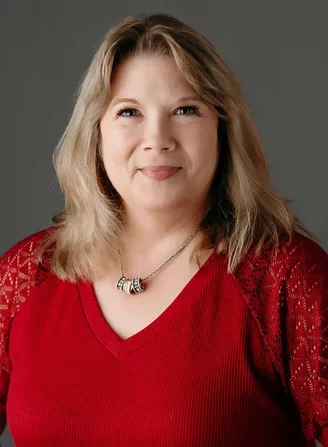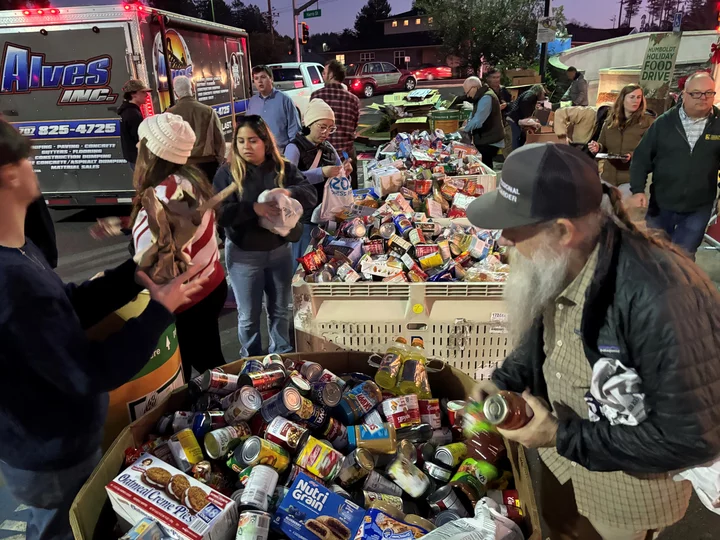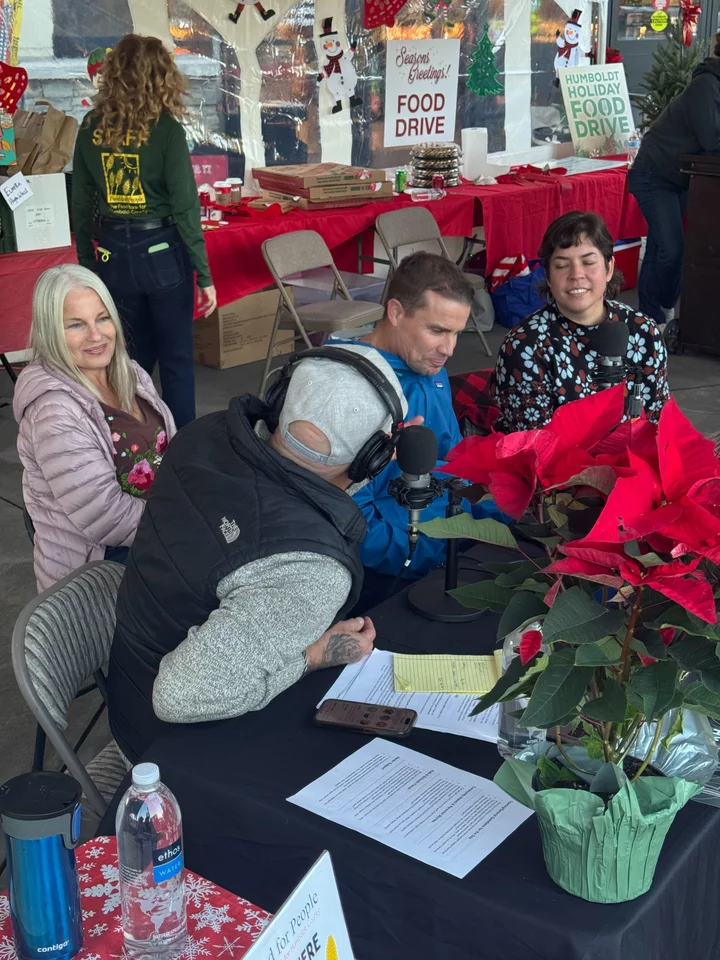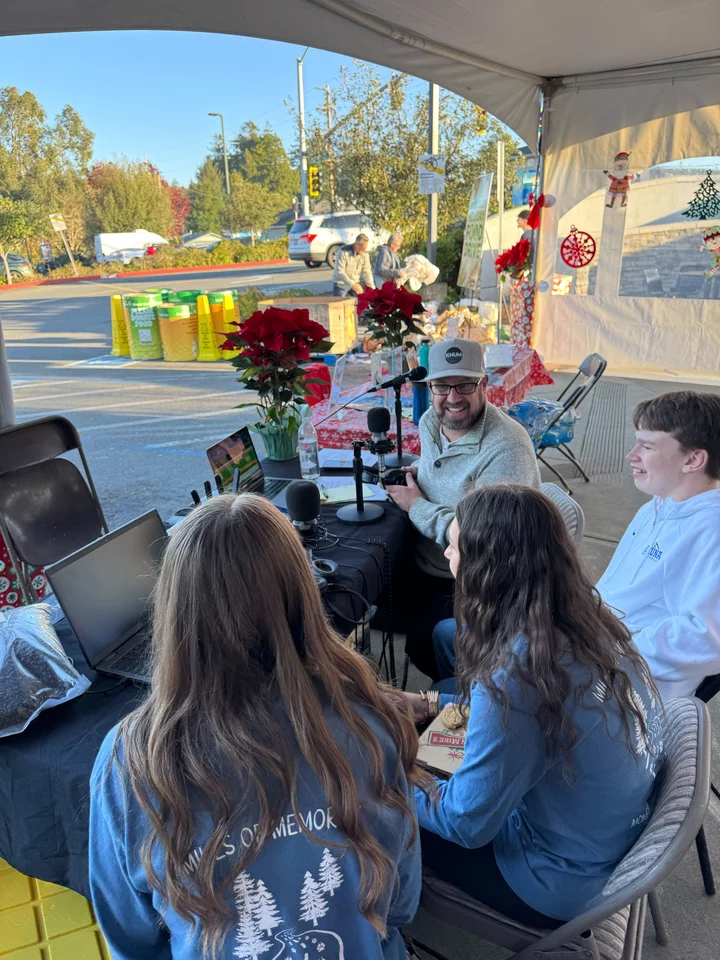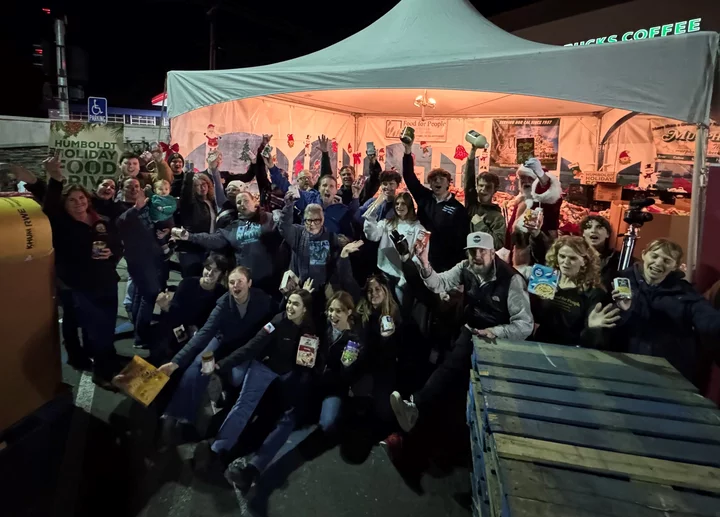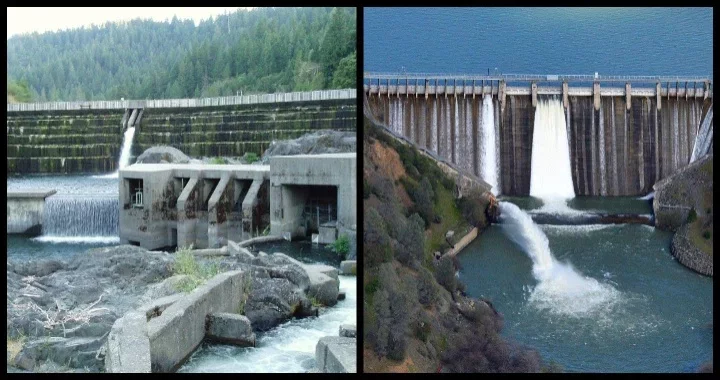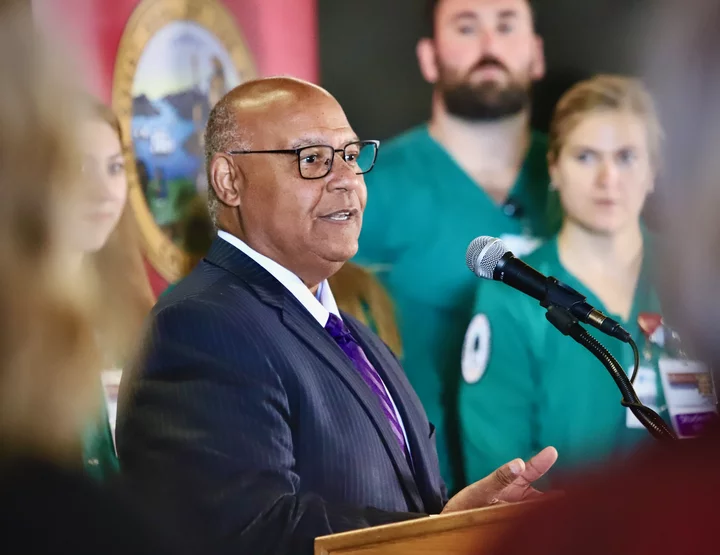OBITUARY: Dillon Nadine Lewis, 1960-2025
LoCO Staff / Saturday, Dec. 13 @ 6:56 a.m. / Obits
Dillon Nadine Lewis, 65, devoted public servant, passionate equestrian, and cherished family member, passed away on September 14, 2025, at her home in Loleta.
Born Dillon Nadine Gage on February 19, 1960, at St. Joseph Hospital in Eureka, she was the daughter of John C. and Ima Gage of Big Bar, California. Dillon attended Trinity High School and built a life rooted in the natural beauty of Northern California. After high school, Dillon joined the U.S. Forest Service in 1978 at the age of 18 and 5 years later, on April 2, 1983, she married Brent Lewis of Big Bar in Weaverville.
Dillon dedicated over 40 years of her life to the U.S. Forest Service, beginning her career on the Shasta Trinity National Forest, Big Bar Ranger District, in fire, fuels and timber. Her commitment to conservation and operational efficiency led her to the Lassen National Forest, Hat Creek Ranger District where she served for a number of years. From there Dillon’s career transitioned to the Six Rivers National Forest, where she continued her contributions to the Agency through decades of service in fire, fuels, prevention, dispatch and eventually culminating with her final official role as the Fleet Manager for the Forest.
Dillon’s contributions to the agency were immense and not easily measured by any standard. She will always be remembered for her selfless service, personal courage, exceptional devotion and dedication, known throughout the Pacific Southwest Region as the “Quiet Storm.” Dillon on many occasions gave up her personal days to ensure the needs of the agency and employees were met, consistently putting the wellbeing of others before her own so that the mission would be successful. The good work, knowledge, guidance and education she provided to her fellow civil servants, and the public at large, will always be valued. Her contributions, and the positive influence she had on all whose lives she enriched, will not be forgotten.
Throughout her life, Dillon had two great passions: German Shepherds and horses. She was rarely seen without a loyal German Shepherd by her side, most notably Yogi her constant companion, who she loved dearly. Yogi, who just recently finished his own journey through this life, is now by his mother’s side once again.
Dillon had many horses throughout her life and was an accomplished equestrian. In the saddle since she was a child, her love for horses translated into a lifetime of riding and competition. She was an avid participant in Gymkhanas and barrel racing, winning numerous events during her life and setting a high bar for friends and competitors alike throughout the equestrian community.
Dillon is survived by her husband, Brent Lewis and sister Gloria Green. She is preceded in death by her mother, father, and sisters Charlene Walkly and Lynn Duvet. A memorial service is planned for January 21 at 11 a.m. at Riverfront Lodge in Fortuna. The family requests that in lieu of flowers, donations be made to a local animal rescue organization in Dillon’s honor.
###
The obituary above was submitted on behalf of Dillon Lewis’s loved ones. The Lost Coast Outpost runs obituaries of Humboldt County residents at no charge. See guidelines here.
BOOKED
Yesterday: 2 felonies, 6 misdemeanors, 0 infractions
JUDGED
Humboldt County Superior Court Calendar: Yesterday
CHP REPORTS
9303 MM1 N MEN 93.00 (UK office): Trfc Collision-1141 Enrt
1500 MM36 E HUM 15.00 (HM office): Mud/Dirt/Rock
1656 Union St (HM office): Closure of a Road
ELSEWHERE
RHBB: Passing the Good Fortune Along: Grant-Funded Engines Reach Piercy—and Roll On to Alderpoint
RHBB: Study Finds Wildfires Can Transform Soil Nutrient Into Long-Lasting Groundwater Contaminant
RHBB: Highway 36 Closed, Driver Describes Narrow Escape as Slide Sends Rocks Onto Road Near Grizzly Creek
RHBB: Large Redwood Falls Across Mattole Road Near Honeydew, Blocking Traffic
OBITUARY: Christyann Emmerson Tanner, 1965-2025
LoCO Staff / Saturday, Dec. 13 @ 6:56 a.m. / Obits
Christyann Emmerson Tanner was born in Duarte, Calif. on December 13, 1965 and passed on November 28, 2025. She was a resident of Rio Dell.
Christyann was preceded in death by her late husband Timothy Tanner; her mother-in-law, Sally Ann Tanner; her niece and good friend Gina Parrish; and family members
Christyann is survived by her daughters Jilian & Brittney (AJ) and her grandchildren; nephew Cody; brother-in-law Chris Tanner; partner Wade Morris and his family; her dog Juniper; best friends in Rio Dell, Pamela Groseman, Theresa Adams, Dodi Weich and Kimberly Chappelle, among other friends
Christyann was a kind, generous person always willing to help. She was funny as all get-out. She never met a stranger. She always brought you little trinkets or brought the dogs treats. Her spirit was enjoyable. She is missed in the Rio Dell community.
Christyann loved the woods and the beach. She is missed and she is loved.
The celebration of life will be held at 1 p.m. on Saturday, December 13th at Crab Park, off of Cannibal Island Road, which is off Eel River Drive in Loleta.
We’re sorry for the late notice. Potluck.
###
The obituary above was submitted on behalf of Christyann Tanner’s loved ones. The Lost Coast Outpost runs obituaries of Humboldt County residents at no charge. See guidelines here.
In Leaked Excerpt of Guilty Plea, Former Fortuna Councilmember Kris Mobley Details $586K Embezzlement Scheme
Ryan Burns / Friday, Dec. 12 @ 4:18 p.m. / Courts
On Wednesday, former Fortuna City Councimember Christina “Kris” Ann Mobley pleaded guilty in federal court to four counts of felony fraud. The crimes were part of a two-year embezzlement scheme Mobley executed while employed as a business manager at Fortuna-based Beacom Construction Co.
Mobley, who was elected to the Fortuna City Council in 2022, abruptly resigned in January in the midst of an FBI investigation into her crimes. She was indicted just over a week later for allegedly stealing more than $500,000 from her employer over the course of almost three years.
The Outpost has obtained an excerpt from the sealed plea agreement in which Mobley acknowledges her guilt and explains in detail how she fraudulently issued company checks to herself, arranged electronic payments to cover her personal credit card debts and falsified her vacation time and payroll checks, ultimately embezzling more than $586,000 from Beacom Construction.
Mobley pleaded guilty to just four of the 10 counts listed in her indictment. In the leaked plea statement she says was effectively the chief operating officer at Beacom, giving her broad access to the firm’s accounting and bookkeeping systems.
Starting in or around January of 2022, Mobley issued a series of checks from the company’s business bank accounts to cover personal expenses, including cash advances at casinos, mobile gambling, restaurants and more.
Mobley also admits to using wire services to arrange nearly $300,000 in electronic payments from Beacom’s bank accounts to her own Capital One credit card account. She had access to blank, pre-signed checks from the company’s owner, for use when he was out of town, and from August 2022 through October 2024 she issued 23 of those checks to herself totaling roughly $51,900, according to the statement.
Lastly, Mobley admits to falsely inflating her vacation time, overstating the number of hours she worked and giving herself unauthorized bonuses over a span of about two years.
Mobley’s sentencing hearing is scheduled for March 18, 2026.
###
PREVIOUSLY
- Fortuna City Council Member Kris Mobley Resigns as FBI Investigates Embezzlement and Theft Allegations, According to City Officials
- Fortuna City Officials Knew About the FBI Investigation Into Former Councilmember Kris Mobley Two Months Before She Vacated the Position
- Former Fortuna City Council Member Indicted on Three Counts of Fraud
WHAT A HAUL! Humboldt Raised 23.5 Tons of Food and $63,000 During the Annual Holiday Food Drive
LoCO Staff / Friday, Dec. 12 @ 2:27 p.m. / :)
Photo: McGuire’s office.
Press release from the office of Sen. Mike McGuire:
Senator McGuire’s 10th annual Humboldt Holiday Food Drive made history yesterday by rallying the community for its biggest day of giving yet, delivering a monumental day of generosity for Food for People, Humboldt County’s food bank. The record-breaking event brought in 23.5 tons of food along with a WHOPPING $63,000 in financial donations, all headed directly to support hungry families across Humboldt County.
Now the largest Food Drive on the North Coast, the Food Drive is powered by a partnership between Senator McGuire, Food for People, KHUM Radio, North Coast News, and six local high schools: Arcata, Eureka, Ferndale, Fortuna, McKinleyville, and St. Bernard’s. This year, Food for People faced the biggest challenge yet in the organization’s 50-year history with massive federal funding cuts to SNAP, the Supplemental Nutrition Assistance Program, stripping away food assistance from 5.5 million needy Californians each year.
Going into the holidays with this year’s historic demand, local businesses and the Humboldt community majorly stepped up the generosity to support Food for People’s 26 food pantries, which serve an average of 21,000 residents every month. In 2024, the organization distributed 2.8 million pounds of food to low-income residents; of those served, 25% are children and 25% are seniors.
“Ten years strong and Humboldt is still showing the world that the North Coast is the most generous place on earth. This year has been incredibly tough for so many families, and the need has truly never been greater. Thousands of students, donors, and neighbors stepped up to make sure no one goes hungry this holiday season,” said Senator McGuire. “This year’s food drive smashed all records, and it didn’t happen by accident — it happened because Humboldt shows up, year after year, for families who need it most.”
Taking home the Golden Can Award this year was, McKinleyville High School once again collected the most food this year with an incredible 17,291 pounds, while Fortuna High School brought in the most financial contributions with $3,340 collected for Food for People. Both schools will receive the coveted Golden Can Award and a $750 check from Senator McGuire for their efforts to be used toward their next school party.
“We are blown away by the generosity last night! Our community is facing a truly unprecedented need this year and the giving we saw yesterday was nothing short of inspiring,” said Carly Robbins, Executive Director of Food for People. “For ten incredible years, Sen. McGuire has brought thousands of people together to help us feed families in need. We’re so thankful for Senator McGuire, for our dedicated high school partners, and for every person who donated food or funds. This outpouring of support means our warehouse will stay stocked for months ahead.”
KHUM DJ Toby Tullis talks with Eureka Mayor Kim Bergel, McGuire and Supervisor Natalie Arroyo at the big event at Eureka Safeway yesterday. Photo: Roger Harrell.
Tullis and teen food-drivers. Photo: Roger Harrell.
Take a bow. Photo: McGuire’s Office.
PG&E Extends Deadline for Comment on Potter Valley Project Dam Removal; Friends of the Eel Urges Humboldt People to Make Their Voices Heard
LoCO Staff / Friday, Dec. 12 @ 1:46 p.m. / Environment
From left: Cape Horn Dam, Scott Dam. Photos via PG&E.
Press release from Friends of the Eel:
PG&E has submitted an application to surrender its license for the Potter Valley Project, and to remove the two defunct dams in the Eel River headwaters. This is a smart economic move, as the project has not generated electricity for over 4 years, and what it did produce over the last 20 years was less than 1% of PG&E’s entire hydropower portfolio. This failed hydroelectric project is costing ratepayers about a million dollars a year for absolutely no benefit, while continuing to cause significant ecological harm to the Eel watershed.
We are currently at a critical juncture – the public’s first opportunity to speak to federal regulators about this project and encourage them to approve PG&E’s plan for dam removal with no delay. The Federal Energy Regulatory Commission (FERC) need to hear from our community about how this plan is broadly supported and benefits public interest. The comment deadline has just been extended, we now have until Friday, December 19 at 2 p.m. to file comments.
The disinformation campaign coming from the MAGA movement has been well-funded and successful in generating ill-informed opposition to this project. Water users who stand to benefit from a more reliable diversion infrastructure, or water users who may have never received any Eel River water, are voicing loud opposition. We must be louder to ensure the Eel River dams are removed in time to save our struggling native fish. You comment can make a difference!
The Potter Valley Project includes an inter-basin diversion of water from the Eel River to the Russian River. The current plan allows for the Eel Russian Project Authority to use some of the existing infrastructure to develop a new dam-free diversion under different rules that are more protective of Eel River habitat, but will continue to provide water supplies to users in the Russian River.
Dam removal is the single most important action we can take to support recovery of the Eel’s still-wild native fish, and allow steelhead to return to over 280 miles of prime habitat in the upper basin. Dam removal will also remove habitat that is ideal for invasive pikeminnow, which thrive in the warmer waters of the Lake Pillsbury Reservoir.
Please take a few moments today to write a comment in support of Eel River dam removal. Use the links below to find instructions for commenting, suggested talking points, a sample letter, and additional information about the Potter Valley Project.
Instructions for commenting here.
Sample letter to FERC here.
Watch a presentation - Why Eel River Dam Removal is Urgent.
Dr. Keith Flamer, College of the Redwoods’ Longtime President, Will Step Down From That Role One Year From Now
LoCO Staff / Friday, Dec. 12 @ 1:22 p.m. / Education
Flamer at the inauguration of the Cal Poly/CR Health Care hub. File photo: Andrew Goff.
Press release from College of the Redwoods:
College of the Redwoods President Dr. Keith Flamer has announced that 2026 will be his final year leading the College. He has formally notified the Board of Trustees of his intent to conclude his service at the end of his current contract on December 31, 2026. The Board will formally acknowledge his notice at its meeting next week.
The Board of Trustees and Dr. Flamer have been working collaboratively for several months to update board policies and administrative procedures related to the presidential search. The Board will begin a formal search for the College’s next president early in the Spring 2026 semester. The process is expected to be thoughtful, transparent, and inclusive.
Board President Colleen Mullery noted that “leadership requires trust, courage, commitment, vision, and the ability to bring disparate groups together to work toward a common goal,” adding that College of the Redwoods “has been blessed with the leadership provided by Dr. Keith Flamer during his tenure as President. While higher education has experienced unprecedented turbulence, he has remained steadfast in his unflinching support for CR students, faculty, staff, and the community.
Dr. Flamer joined College of the Redwoods in July 2006 and has served the institution for nearly two decades, first as Vice President of Student Services, then Vice President of Student Services and Instruction, and for the past ten years as President. While the decision was difficult, he stated that the College is well positioned for a leadership transition.
Under Dr. Flamer’s leadership, the College resolved significant accreditation and financial challenges, strengthened community partnerships, expanded distance education infrastructure, improved employee compensation, and fully recovered enrollment lost during the pandemic. The College is now positioned to surpass enrollment targets and grow general fund revenue. Significant investments have also been made in faculty and in healthcare and career education programs.
Major facilities projects undertaken during his tenure include the Creative Arts Complex, community stadium renovation, and the new PE Complex and Fieldhouse. Upcoming projects include affordable student housing on the Eureka Campus, the Del Norte Healthcare Education Training Center and renovation, and the joint Cal Poly Humboldt/CR Healthcare Education Hub.
“None of this progress would have been possible without the dedication of our faculty, staff, students, administrators, the Board of Trustees, and our community partners,” Dr. Flamer said. “It has been the honor of my career to serve College of the Redwoods.”
Dr. Flamer will remain fully engaged as President through the end of his contract and will continue advancing the College’s priorities while supporting a smooth leadership transition.
(VIDEO) Power Line Erupts in Flashes, Bangs and Smoke Near Eureka High, Causing a Small Outage
Ryan Burns / Friday, Dec. 12 @ 12:41 p.m. / News
###
A power line draped above I Street near Eureka High School shorted out in dramatic fashion this morning, sending sparks and smoke into the air as electricity danced across the cable.
The footage above was sent to the Outpost by Nadia Eberman, who captured the light show from her parked car. She said drivers stopped before passing under the live wire, and Humboldt Bay Fire responded to the scene.
Commenters online diagnosed the event as a phase-to-phase short, which occurs when two conductors in a three-phase system make direct contact. Such short circuits can create a massive surge of current, triggering intense arcing, bright flashes, loud bangs and significant heat.
The zapped line did cause a power outage along a block of I Street, though it only affected 14 customers, according to PG&E.

